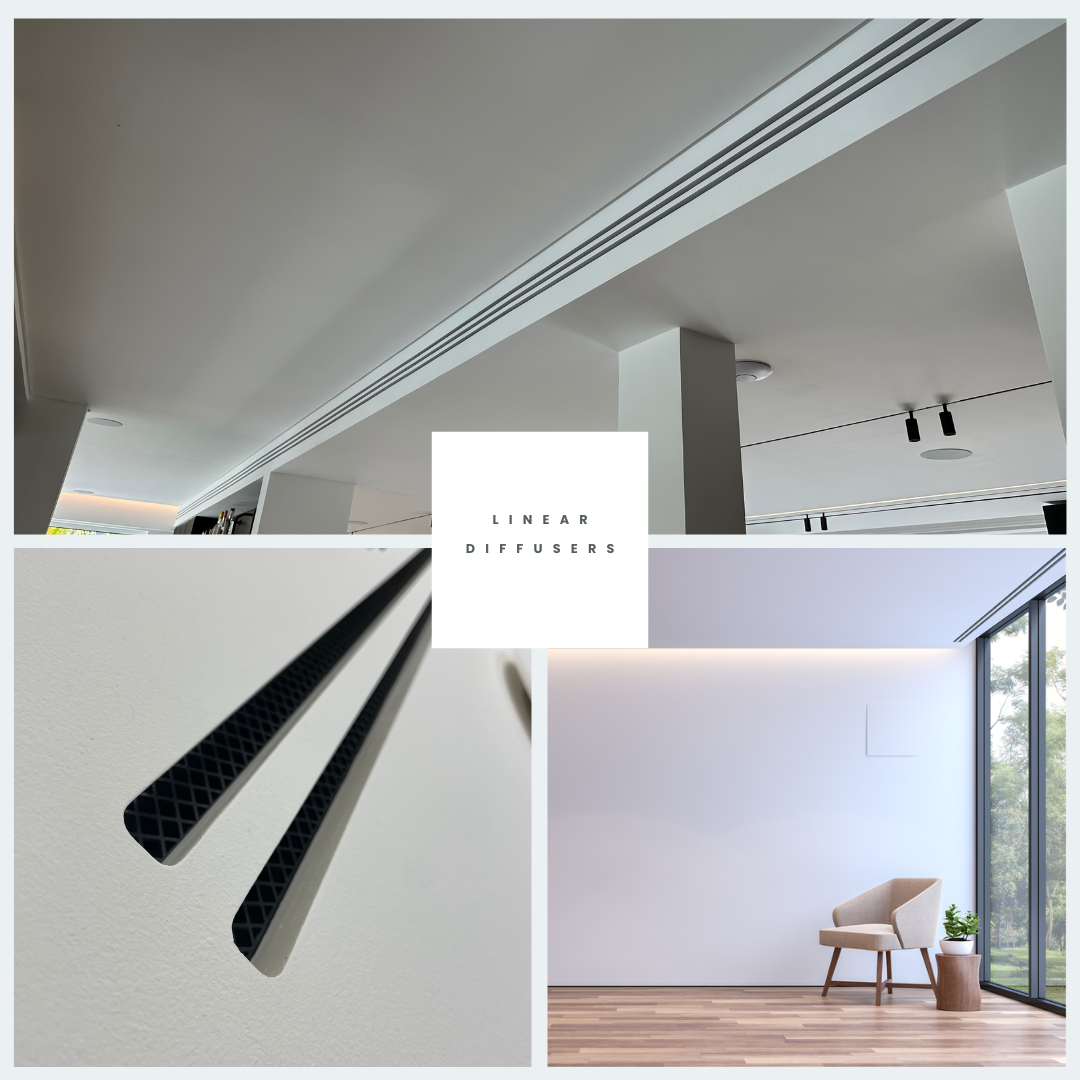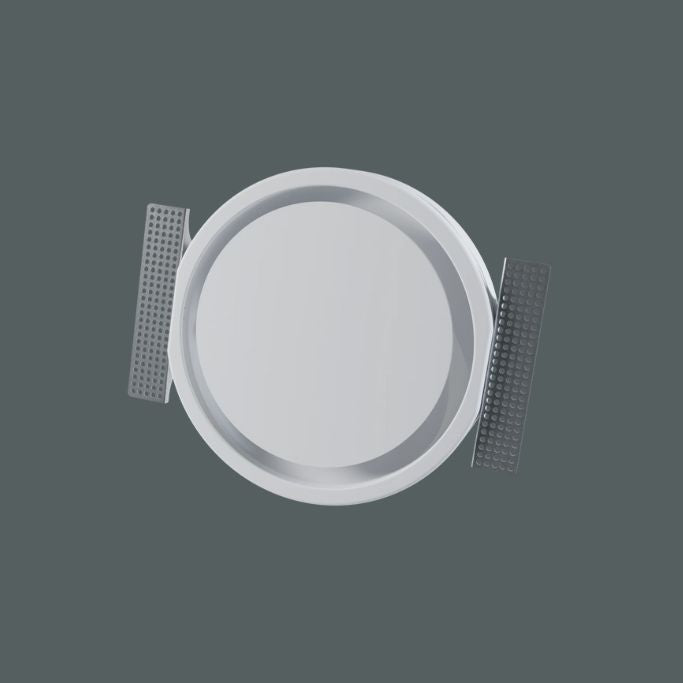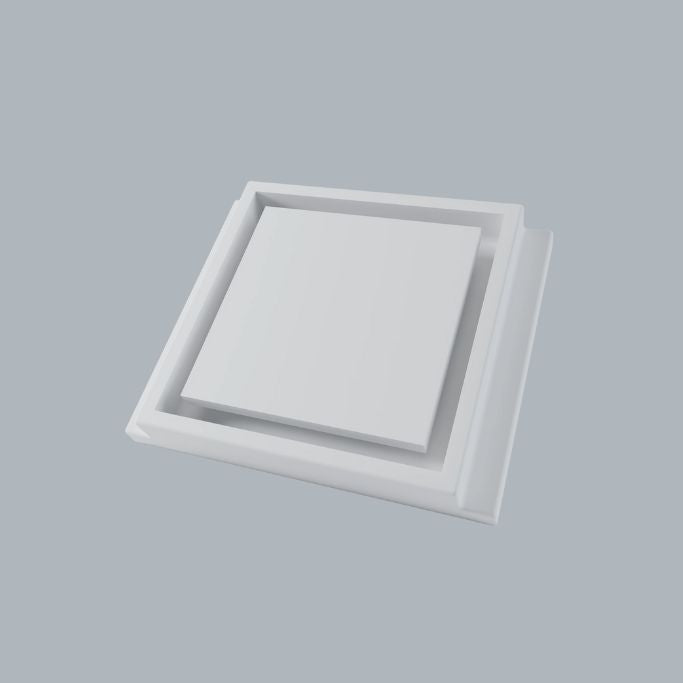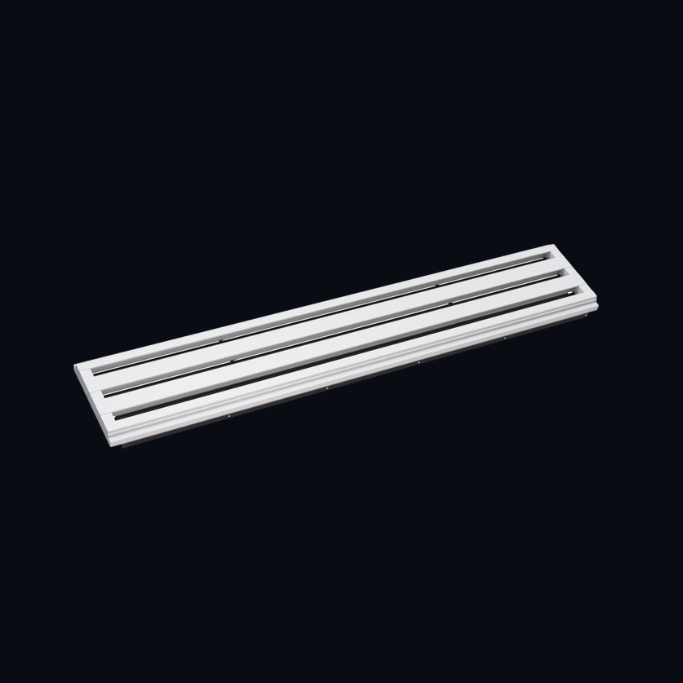
Answers made simple
FAQs
Yes, despite being new to market (since 2022) our diffusers have been installed widely across the UK, meeting with delight from all of our clients, ensuring a large percentage of re-orders.
Yes! Anywhere you are using plasterboard, you can use our diffusers. As the product have a resin binding material, they are more resilient to damp conditions than regular gypsum plasterboard.
Absolutely. MVHR system are often installed in energy efficient houses where the modern design and excellent operating parameters of our vents provide a discreet solution for both supply and extract air flows.
Our products provide a flush, frameless interface with the surrounding plasterboard. When installed, they are painted the same colour as the wall or ceiling. So a better question might be "how often do you need to clean your plasterboard?". Even if the HVAC installation produces dirty air (and a well designed one won't!) the vent can be easily wiped and/or repainted if it becomes marked.
Essentially yes. The plaster vents we supply represent just the room-facing component of the ventilation system. Fans, cooling systems and ducting are by others.
Our slot linear diffusers are fairly straightforward to install, but - being an innovative product - they do differ to standard grilles. Speak to us about our online courses and approved installers list.
Our linear slot diffusers come in three lengths - 625mm, 1000mm, 1250mm, with one, two or three slots and gap widths of 12mm and 18mm
Our round, square and side diffusers come in various spigot sizes of 100mm, 125mm, 160mm, 200mm and 250mm
Our performance range of diffusers utilise a principle in airflow known as the Coanda effect. This phenomenon describes how a moving stream of air (or fluid) tends to curve and follow a nearby surface.
Here's a breakdown of the Coanda effect:
Airflow and Entrainment: Normally, air flowing from a source (like a Ventmann grille) mixes with the surrounding air as it travels (entrainment).
Introducing a Curved Surface: When a curved surface is placed near the airflow, it disrupts the entrainment on that side.
Pressure Difference: This disruption creates a pressure difference. The pressure on the opposite side of the jet remains higher, pushing the airflow towards the curved surface.
Curvature and Attachment: As the airflow gets closer to the surface, it curves further due to the pressure difference. Eventually, the airflow attaches itself to the curved surface and follows its shape, eventually also attaching itself to the neighbouring wall or ceiling.
The Coanda effect can be beneficial in many situations, influencing airflow patterns and potentially improving efficiency. However, it's important to consider this effect during design to ensure optimal performance.
If you have any further questions about the Coanda effect or its application in Ventmann products, please don't hesitate to contact us.
No, Ventmann diffusers are specifically designed for integration withgypsum board and plaster systems. They require solid substrate mounting and plastering for proper installation and aesthetic integration. For stretch ceiling applications, traditional diffuser solutions would be more appropriate.
Selection depends on several factors:
- Airflow requirements: Use our technical parameters to match capacity
- Aesthetic preferences: Choose from LINE, CIRCLE, SQUARE, or ART models
- Installation type: Consider ceiling construction (single/double gypsum board)
- Acoustic requirements: Reference our sound pressure level data
- Space constraints: Review throw distances and coverage patterns
Our sales team provides free technical consultation and sizing assistance for all projects.
Traditional air vents have a plastic or metal grille requiring a frame that sits proud of the plasterboard surface or that is obviously a different material to the surroundings. Ventmann frameless diffusers have no such visual impact as they are plastered-in to the surrounding surface using a light skim. As the product is made from gypsum, the mechanical properties are the same as the wall or ceiling ensuring the final painted interface is invisible.
Yes, all our products include adapters for both single and double gypsum board installations. The magnetic mounting system distributes load effectively, making single-board installation safe and reliable when following our provided instructions.
Assuming the required filtration is used elsewhere in the HVAC system, our diffusers make excellent medical and clean room vents and grilles due to their simplicity and ease of cleaning.
The decibel level (dB) on our website shows the flow rates below which there is inaudible noise. We use 17dB as the level at which we deem the flow rate to be inaudible, whereas the industry standard tends to be 25dB. We do this to allow for other factors within the system including air flow damping and excessive velocity.
Yes, our LINE series is specifically designed for continuous installation:
- Individual units connect with minimal visible gaps
- Plaster filling creates perfectly seamless appearance
- Lengths can extend indefinitely across spaces
- Maintains consistent airflow performance throughout
This capability enables striking architectural features while maintaining excellent air distribution.
All of our vents can be used on walls and ceilings. We think our Side Square and Side Round diffusers look particularly stunning on walls where they can be used to produce a Coanda effect where the air flow stays attached to the surface for longer
All Ventmann products are designed, patented, and manufactured in EU using our proprietary gypsum composite technology. Our manufacturing facility maintains the highest quality standards, ensuring each diffuser meets precise dimensional tolerances and performance specifications. We conduct rigorous testing for pressure drop, sound levels, and airflow characteristics according to industry standards.
Our production schedule varies by product line:
- CIRCLE, SQUARE, and SIDE models: In stock, immediate delivery
- LINE series: 2 days to 3 weeks (partially stocked due to customization options)
- ART grilles: 1-2 weeks depending on design complexity
- PERFORMANCE LINE: usualy in stock, or 2-3 weeks for specialized configurations
Our technical catalog provides comprehensive performance data includingpressure drop curves,sound pressure levels, andthrow distancesfor each model. For example, ourLINE 1/12 modelachieves effective areas from0.0067 to 0.0135 m²withsound levels below 20 dB(A)at standard airflow rates. All models are tested forsupply and exhaust applicationswith detailed acoustic performance data.
We use aproprietary gypsum compositethat’s completelynon-toxic and environmentally safe. The material featuresA1 fire classification, meaning it’s non-combustible. Unlike conventional plastic or metal diffusers, our gypsum-based productsdon’t emit harmful substancesand arenaturally antimicrobial, contributing to healthier indoor air quality.
Our diffusers excel in:
- Luxury residential projects where design aesthetics are paramount
- Commercial spaces including offices, hotels, and retail environments
- Healthcare facilities requiring silent operation and easy maintenance
- Educational buildings needing acoustic comfort
- High-end hospitality where invisible integration is essential
Each application benefits from our models’ ability to blend seamlessly into any architectural design while maintaining exceptional performance.
Yes, our diffusers work with:
- Traditional HVAC systems
- Heat pumps and air conditioning units
- Recuperation systems with heat recovery
- Humidification systems
- Both supply and exhaust applications
Standard connection diameters (100mm, 125mm, 160mm, 200mm, 250mm) ensure compatibility with most ductwork systems.
We providecomprehensive warranty coveragefor all manufacturing defects and performance specifications. Specific terms vary by product line and application. Contact our sales team for detailedwarranty information and registration proceduresfor your specific project.
Installation varies by model but follows these principles:
CIRCLE/SQUARE models:
- Mount adapter between gypsum board layers
- Secure with provided brackets
- Apply gypsum/plaster over surface
- Attach magnetic cover after finishing
LINE models:
- Install steel backing plate in ceiling cavity
- Mount gypsum segments with magnetic system
- Plaster and finish with surrounding surface
- Paint to match ceiling color
ART grilles:
- Frame-based installation with magnetic locking
- Custom cutting for specific opening sizes
- Professional mounting system included
Video installation guides are available via QR codes in our catalog.
Routine maintenance:
- Our gypsum material doesn’t require regular cleaning
- If soiling occurs, clean dry (avoid moisture to prevent dirt absorption)
- Diffuser interior can be painted separately from ceiling if needed
Access for maintenance:
- Magnetic covers remove easily for filter access or duct inspection
- No tools required for cover removal
- Interior access maintains ceiling finish integrity
LINE models: Feature adjustable deflectors for precise airflow control in left, center, or right positions. This allows optimization for room layout and comfort requirements.
CIRCLE/SQUARE models: Utilize our Coanda effect technology for natural air circulation along ceiling surfaces, reducing drafts and improving comfort.
PERFORMANCE LINE models: Include specialized deflector options (standard, perforated, or no deflector) for maximum application flexibility.
Not at all!The installation of Ventmann diffusers isefficient and streamlined, often completed in one session alongside your ceiling or wall construction. This process cansave up to 40% in installation timecompared to standard diffusers, accelerating your project timeline and reducing costs. Ourmagnetic mounting systemsimplifies installation without causing significant disruptions to your space. Thesingle-phase installation approachmeans no return visits for finishing work, keeping your project on schedule.
Yes, our technical team provides:
- Airflow calculations and system sizing
- Acoustic analysis for noise-sensitive applications
- Custom installation drawings and specifications
- Integration guidance for complex projects
- On-site technical support for large installations
Our PERFORMANCE LINE models utilize the Coanda effect, where air naturally follows curved surfaces. This aerodynamic phenomenon:
- Spreads air along the ceiling rather than dropping immediately
- Reduces drafts in occupied zones
- Improves temperature distribution
- Enables higher air change rates with better comfort
- Allows more efficient heating and cooling
Patented magnetic mounting:No visible frames or mechanical fastenersGypsum composite material:Completely paintable and plasterableIndustrial-grade magnets:Secure mounting with easy accessCoanda effect technology:Enhanced comfort through natural airflowModular connectivity:Seamless continuous installationsAcoustic optimization:Ultra-quiet operation for premium environments
Absolutely!Our diffusers areversatile and idealfor both new builds and renovation projects. Whether you’re constructing a new space or updating an existing one, Ventmann diffusersintegrate effortlesslyinto ceilings and walls where drywall is used. Theirseamless design and easy installationmake them a practical choice for enhancing air distribution and interior aesthetics in any setting. This flexibility allows architects and designers to specify our solutions across diverse project types while maintainingconsistent aesthetic excellence.
Absolutely!Our diffusers can beplastered over and paintedwith the same materials and colors as your surrounding surfaces, making themvirtually invisibleor a subtle design element. Withfour customizable models—Circle, Line, Side, and Square—plus ourART serieswith decorative patterns, you have complete flexibility to choose a style that complements your space. Whether it’s amodern corporate officeor aluxurious residential setting, our diffusers adapt to your design vision while maintaining exceptional performance.
Can’t find what you’re looking for? Contact us.
Unit 26-28 Lichfield Trading Estate
Tamworth, B79 7XD
United Kingdom
sales@ventmann.co.uk
+44 (0)1283 240025 Open in maps
Monday - Friday
8am - 5pm
Blog posts

Ventmann UK to Exhibit at London Build Expo 2025 – The UK’s Largest Construction Show

What Is a Linear Diffuser? Everything You Need to Know
In modern interior design and HVAC (Heating, Ventilation, and Air Conditioning) systems, linear diffusers have emerged as a go-to solution for spaces that demand both style and functionality.

Air Ventilation Grilles: Elegant Design Meets Engineering Performance
In today’s built environments, maintaining excellent indoor air quality is essential for health, comfort and regulatory compliance.



